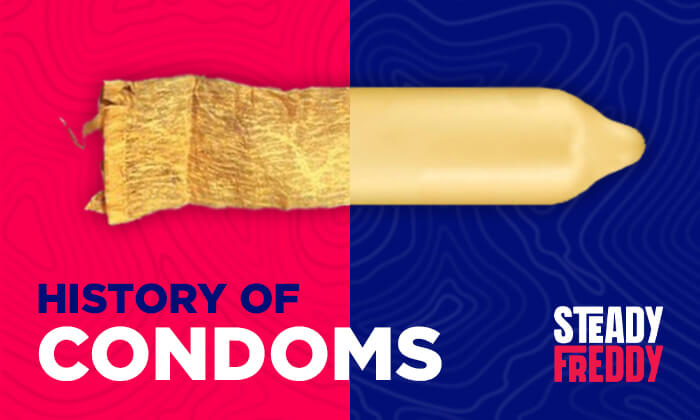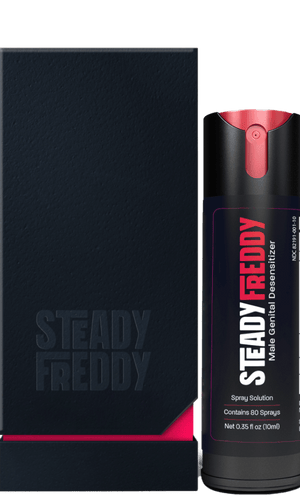For many centuries, condoms have helped protect against sexually transmitted infections (STIs), sexually transmitted diseases (STDs), and unwanted pregnancies.
From the first ever-worn animal skin condom to the ultra-thin, flavored, textured, studded, and even the famous ejaculation-delaying condom, there has been a subtle yet powerful transformation in the design and function of condoms throughout history.
In this article, we discuss the most significant historical events that have led to the development of condoms.
Note: Read the whole article or scroll down to the KEY TAKEAWAYS section at the end of this article for a short summary.
When Were Condoms Invented?
Unknowingly at the time, these condom sheaths would help protect women against syphilis, which first appeared in 1495, sweeping rapidly across most of Europe.
What may come as a surprise to many is how far back the first-ever condom was used. Dating back to 3000 B.C., King Minos of Crete went down in history for creating the first of its kind "condom".
During this period, semen was thought to contain deadly scorpions and serpents. To help protect his wife, Pasiphae, King Minos assembled a goat's bladder inside her vagina before sex. Interestingly, this first condom-like creation was technically in the form of a female (or internal) condom.
Skipping ahead to 1,000 C.E, ancient Romans and Egyptians would use linen sheaths to create male (external) condoms. Unknowingly at the time, these condom sheaths would help protect women against syphilis, which first appeared in 1495, sweeping rapidly across most of Europe.
By 1564, condom usage was first recorded in print as protection against "The French Disease".
ALSO READ: 7 Tips on How to Prepare for Anal SexCondom Historical Timeline
Spending his life searching for attractive women, showering them with compliments, and engaging in a lot of sex, it's no surprise that this Italian womanizer used condoms too!
Following the first recorded evidence of what we now know as "the condom", numerous historical events have taken place to help shape the progression of the condom. Let's dive into some of the more significant events in condom history.
The Casanova Condom Era
Giacomo Casanova was an Italian traveler of the 1700s who made it into history for many reasons. Known as a scam artist, a spy, and even an alchemist, Casanova continues to be best known today as one of the most famous lovers in history. Spending his life searching for attractive women, showering them with compliments, and engaging in a lot of sex, it's no surprise that this Italian womanizer used condoms too!
Although throughout Casanova's younger years, he did not express much interest in using condoms as he mentions that he didn't like "shutting [himself] up in a piece of dead skin to prove that [he was] well and truly alive".
As time went on, Casanova began using condoms after realizing the importance of disease protection. Perhaps the earliest use of "quality control", Casanova would inflate these animal skin condoms to test for any holes or leaks before using them.
When and How Condoms Got Their Name
While the origin of the word "condom" is not well-understood, many believe that the name came from "Dr. Condom" (or Conton), who was at the court of King Charles II in the 1600s. However, another theory explains that the name was derived from the Latin word "condus", meaning receptacle or an object or space used to contain something.
The Transformation of Condom Material
Since the early days, condoms were made using a variety of different crude animal products or linen. From tortoise shells to animal intestines, oiled silk paper to thin leather, condoms did not differ much across Europe throughout the 18th century.
If you think that today's ultra-thin condoms are uncomfortable, guess again...
During this time, the animal-skin condom market was dominated by two rivals: Mrs. Phillips and Mrs. Perkins. Each offering a one-size-fits-all condom, their products were a simple recipe made using the finest skins and bladders.
From Animal to Rubber
Fast forward to the mid-19th century, the progression of new rubber manufacturing methods opened the gates to the invention of the first rubber condom in 1855.
Charles Goodyear, the inventor of rubber condoms, used a process known as vulcanization to turn weak, inflexible rubber into condoms. By introducing Sulphur dust into natural rubber, he realized that vulcanization would create more durable, form-fitting, and flexible rubber condoms.
By the 1860s, rubber condoms were being mass-produced as more people recognized this new material's comfort and durability compared to animal skin. Unbeknownst to Mr. Goodyear, the vulcanization process would pave the way for a whole world of possibilities in future condom production.
The Invention of Latex Condoms
In 1920, latex was invented by suspending vulcanized rubber in water, making it much thinner, stronger, and longer-lasting than any other condom material. In fact, Trojan was the very first official condom brand that manufactured and sold latex condoms. Even today, Trojan is one of the leading brands in the condom industry for making the most durable and reliable latex condoms.
The Sexual Revolution
Between 1960 and 1970, the sexual revolution took place. This social and cultural movement was responsible for transforming the way people thought about sex and erotic behaviors. Rather than repressing or stigmatizing sex, the sexual revolution helped liberate more people to enjoy and celebrate sex.
With this came safer sex practices.
As the stigmatization around sex before marriage decreased (especially for women), birth control pills were developed to help improve access to reliable contraception. As a part of condom history, this revolution made it clear to society that sex was meant for pleasure rather than to conceive a child. For this reason, more women opted to use condoms to protect against unwanted pregnancies.
The Spread of AIDS
Over the 20th century, the human immunodeficiency virus (HIV) evolved into what is known now as acquired immunodeficiency syndrome (AIDS). When left untreated, this life-threatening condition causes your body to feel weak and unable to fight off infections.
Although HIV was known to originate in Africa, it made its way to the United States in 1980, where it evolved into the first reported case of AIDS. Between 1980 and 1990, the Center for Disease Control and Prevention recognizes the increased risk of AIDs in the male homosexual community.
As AIDS continued to spread throughout these years, there was an evident increase in the growth and diversification within the condom industry, with growing research and public education on STIs and STDs, condom sales spiked by an astounding 116% by 1986.
ALSO READ: Condom Size Chart: Your Guide to Condom SizesThe Development of New Condom Types
As we make our way into the 90s, the rising numbers of deaths from AIDS caused several major condom manufacturers to quickly produce a variety of new condom types to help promote safe sex practices amongst couples. Introducing unique condom types such as flavored, ribbed, and ultra-thin, the push towards greater condom diversity was underway.
The First Official Female Condom
The female condom, also known as an internal condom, is a type of contraceptive barrier that is used during sexual intercourse to protect against STIs and unwanted pregnancies. Designed by a Danish doctor, Lasse Hessel in 1979, his invention would eventually be launched in Europe in 1990 and approved by the FDA to be sold in the USA in 1993.
Created as an alternative to the male condom (an external condom), female condoms were made for the woman's comfort, pleasure, and protection.
ALSO READ: Cunnilingus: What Is It & 5 Techniques How to Do ItCondom Diversity
Throughout condom history, the purpose of condom use has changed quite significantly over the years. Originally used to protect sexually active partners from contracting life-threatening infections, diseases, and even unwanted pregnancies, condoms are now marketed towards male and female pleasure above all else.
New Flavors, Textures, and Levels of Lubrication
Since the 90s, condom companies began to manufacture new and exciting designs as a way to explore and indulge in sexual activity, including foreplay, vaginal penetration, and anal sex. Throughout these years, condom flavors, textures, and lubrications were used to give men and women a more enjoyable sexual experience.
ALSO READ: What's your best sex position? Let's find out.KEY TAKEAWAYS
- The first-ever condom was created from animal intestines and used internally on a woman, making it the first female/internal condom made to protect couples from venereal diseases.
- Since the discovery of rubber vulcanization, latex condoms were created to offer greater flexibility, comfort, and longer-lasting durability. Trojan was the first company to mass-produce latex condoms during this time.
- The sexual revolution helped empower people to enjoy and celebrate sex rather than repress and stigmatize it.
- The AIDS scare played a significant role in the spike in condom sales as a way to protect couples from disease and infection.
- By the mid-to-late 90s, the condom industry exploded in diversity as they explored new condom ideas built for pleasure. Some of these unique condom types include textured, flavored, lubricated




